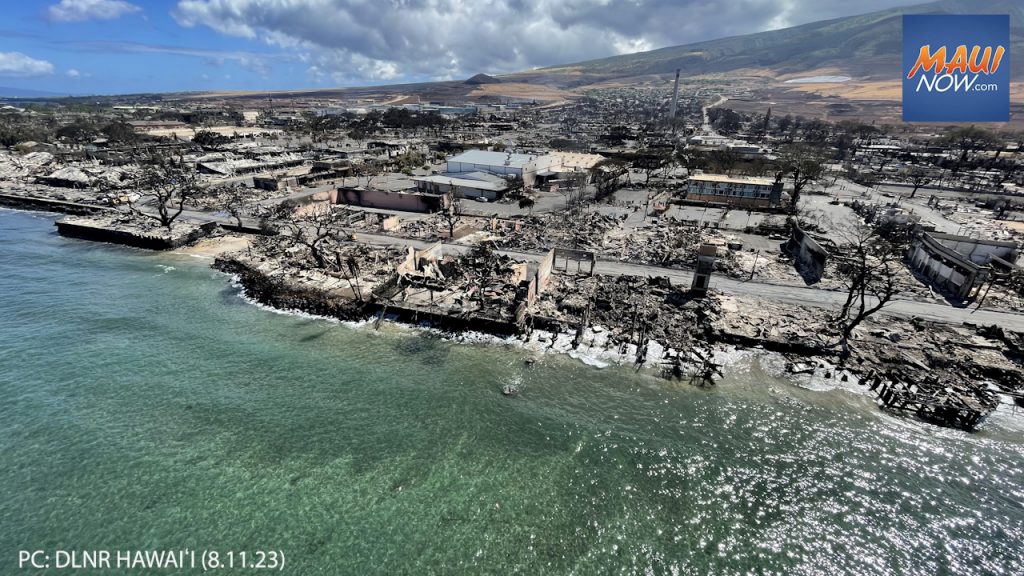EPA begins months-long work of removing hazardous material from 5-square-mile burn area in Lahaina

The US Environmental Protection Agency on Tuesday began the next phase of the Lahaina recovery effort: removing and disposing of hazardous materials in the 5-square-mile burn area.
This work was able to start due to the completion of the search for remains of fire victims on land. The search continues in the ocean for possible victims.
The EPA is using work teams that just completed the removal of hazardous materials from the 19 homes and structures that burned in the Kula and Olinda fires in Upcountry Maui. There are about 150 people on the teams, with about 30% local hires who the EPA trained in hazmat tech certifications.
More teams will be called in as needed to help with the much larger removal and disposal project in Lahaina — where more than 2,200 homes, businesses, multi-unit dwellings and structures were destroyed.
The Lahaina hazardous cleanup is expected to take several months to complete. And, it will be “challenging,” with the possibility of many “unstable” lithium ion batteries from many solar panel systems, EPA incident commander Steve Calanog said during an news conference Tuesday in Wailuku.

To ensure that the work is done with reverence and respect to the Hawaiian history and culture, the EPA has given health and safety training of hazardous material to about 25 cultural leaders from the Maui community who will embed with EPA teams to monitor the operations.
“We all know of the rich and long historic and cultural significance of Lahaina,” Calanog said. “Weʻve been working since we got here with cultural leaders and archeologists from Maui, and especially from the Lahaina area.”
Once hazardous materials are removed, and safety assessments are done on the structural integrity of buildings that are still standing, people and business owners will be allowed to return to their properties.
Maui County Mayor Richard Bissen said the EPA will be doing its work in sections, so most people will not have to wait until all the hazardous removal work is done to be able to return to their properties.
The hope is when one section is completed and deemed safe, residents or business owners with property in that area can return to their properties, Bissen said.
“We’re calling the phase after the hazardous material removal phase, the ‘Return to Lahaina’ phase,” said Darryl Oliveira, the interim administrator of the Maui Emergency Management Agency. “We really want to stress we want to get people back home.”
Once the EPA completes its work, the second part of the debris removal effort can begin. It will be spearheaded by the US Army Corps of Engineers, Hawaiʻi Gov. Josh Green said Tuesday in a news release.
With the selection of the Army Corps for the debris removal, Bissen said much of the high cost will be paid for with federal funding.

In this debris removal phase, Bob Fenton, the chief federal response coordinator of this incident for FEMA, said: “No removal will begin without the permission of the property owner. To the affected residents, please know, we will work with you.”
Officials say it also will be done with the same cultural sensitivities of the hazardous removal phase.
“In discussions with FEMA, we reached an understanding that extra consideration will be given to embedding Hawai‘i’s cultural experts into the mission,” Green said. “There will also be a focus on utilizing local businesses and paying prevailing wages for the debris removal effort.
But first, the EPA must do its work.
The EPA will have an electrician on-site to advise field teams on safely de-energizing and removing home “powerbank” batteries used primarily for solar power systems.
“And there are a lot,” Calanog said.
If lithium ion batteries are damaged to the point they become unstable, “we treat them like unexploded ordinances,” Calanog said. “We have to handle them with great care. The removal of them, the transportation and final disposition of them is a very sophisticated process.”
During this hazardous removal phase, permission is not needed from property owners because the work is done under state emergency orders.
But officials emphasized that EPA workers are removing only hazardous material. No personal items will be removed.
Calanog said the hazardous material will be easily identifiable and easily removable. They include paints, cleaners, solvents, oils, batteries, pesticides and big pieces of asbestos. Asbestos that may be in the ash will be removed in the next phase.
Fuel from pressurized cylinders and tanks also will be removed, but some empty containers of fuel will be marked for removal during the next phase.
The EPA said in a news release it will stop work immediately and contact the Maui Police Department if functional firearms or suspected remains are found.
After household hazardous material is removed, EPA may mist a fine, non-toxic, marine-safe and biodegradable adhesive called “Soiltac” on ash on some properties.
This would be done to prevent ash from blowing into the ocean to do further damage to the environment. The State of Hawaiʻi and Maui County approved the use of this adhesive, which dries clear.
While working to remove household hazardous material, EPA also will monitor the air for fine particles of dust called “particulate matter.” The air monitors will be listed on EPA’s Air Now website.
Meanwhile, Lt. Col. Ryan Pevey, the Honolulu District Commander for the US Army Corps of Engineers, said the Corps has begun planning its debris removal work, which will be even more time consuming than the hazardous material removal.
He said it also will be conducted “safely and with respect to the families and the indigenous and multicultural history of these communities.”








